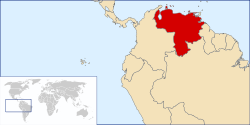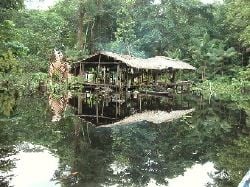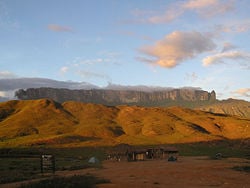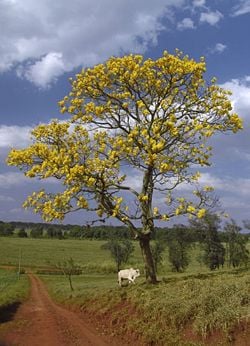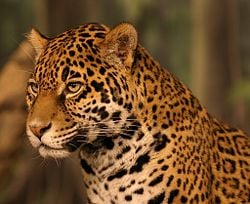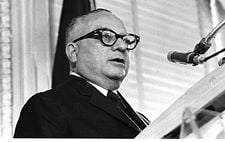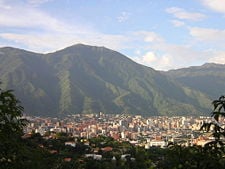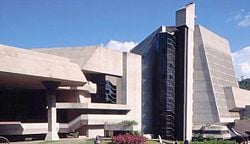Venezuela
| República Bolivariana de Venezuela Bolivarian Republic of Venezuela1 |
||||||
|---|---|---|---|---|---|---|
|
||||||
| Motto: Historic:
Dios y Federación (Spanish) "God and Federation" |
||||||
| Anthem: Gloria al Bravo Pueblo (Spanish) Glory to the Brave People |
||||||
| Venezuela
|
||||||
| Capital (and largest city) | Caracas 10°30′N 66°58′W | |||||
| Official languages | Spanish2 | |||||
| National language | Spanish2 | |||||
| Demonym | Venezuelan | |||||
| Government | Federal presidential constitutional republic | |||||
| - | President | Nicolás Maduro | ||||
| - | Vice President | Tareck El Aissami | ||||
| Independence | ||||||
| - | from Spain | 5 July 1811 | ||||
| - | from Gran Colombia | 13 January 1830 | ||||
| - | Recognized | 30 March 1845 | ||||
| - | Current constitution | 20 December 1999 | ||||
| Area | ||||||
| - | Total | 916,445 km² (33rd) 353,841 sq mi |
||||
| - | Water (%) | 0.323 | ||||
| Population | ||||||
| - | 2016 census | 31,775,371[1] | ||||
| - | Density | 33.75/km² (181st) 87.42/sq mi |
||||
| GDP (PPP) | 2017 estimate | |||||
| - | Total | $404.109 billion[1] | ||||
| - | Per capita | $12,859[1] | ||||
| GDP (nominal) | 2017 estimate | |||||
| - | Total | $251.589 billion[1] | ||||
| - | Per capita | $8,004[1] | ||||
| Gini (2013) | 44.8 | |||||
| Currency | Bolívar fuerte4 (VEF) |
|||||
| Time zone | UTC-04:30 | |||||
| Internet TLD | .ve | |||||
| Calling code | [[++58]] | |||||
| 1 The "Bolivarian Republic of Venezuela" has been the full official title since the adoption of the new Constitution of 1999, when the state was renamed in honor of Simón Bolívar. 2 The Constitution also recognizes all indigenous languages spoken in the country. 3 Area totals include only Venezuelan-administered territory. 4 On 1 January 2008 a new bolivar, the bolívar fuerte (ISO 4217 code VEF), worth 1,000 VEB, was introduced. |
||||||
Venezuela, known since 1999 as the Bolivarian Republic of Venezuela, is a country on the northern coast of South America. Its former president, Hugo Chávez, promoted his socialist "Bolivarian Revolution" as a model for other countries to follow. Closely allied with Cuba, Chávez had a pronounced influence in much of the region during his 14 year rule as president, which ended with his death from cancer in March, 2013.
A former Spanish colony, today Venezuela is known for its petroleum industry, its biodiversity, and its natural features, including Angel Falls. Located in the Guayana highlands, it plunges off the edge of a "tepui," or table-top mountain, and falls 2,421 feet to the river below, making it the tallest waterfall on earth.
Venezuela is also among the most urbanized countries in Latin America, and the vast majority of Venezuelans live in the cities of the north, especially in the largest metropolis, Caracas. Other major cities include Maracay, Maracaibo, Barquisimeto, Valencia, and Ciudad Guayana.
Etymology
The name "Venezuela" is believed to have originated from the cartographer Amerigo Vespucci who, together with Alonso de Ojeda, led a 1499 naval expedition along the northwestern coast's Gulf of Venezuela. On reaching the Guajira Peninsula, the crew observed the distinctive stilt villages, palafitos, that the indigenous Añu people had built over the water. This reminded Vespucci of the city of Venice (Italian: Venezia), so he named the region "Venezuola," meaning "little Venice" in Italian. In Spanish, the suffix -zuela is used as a diminutive term.
Martín Fernández de Enciso, a member of Vespucci and de Ojeda's crew, states in his work Summa de Geografía that the indigenous population they found were called "Veneciuela," suggesting that the name "Venezuela" may have evolved from a native word. The Vespucci story, however, remains the most popular and accepted version of the origin of the country's name.
Geography
The country comprises a continental mainland and numerous islands in the Caribbean Sea. It borders Guyana to the east, Brazil to the south, and Colombia to the west. Trinidad and Tobago, Barbados, Curaçao, Bonaire, Aruba, Saint Vincent and the Grenadines, and the Leeward Antilles lie to the north, off the Venezuelan coast. Falling within the tropics, Venezuela sits close to the Equator, in the Northern Hemisphere. Its size is equivalent to the combined area of France and Germany.
Venezuela's mainland rests on the South American Plate; with 2,800 kilometers (1,740 mi) of coastline, Venezuela is home to a wide variety of landscapes. The extreme northeastern extensions of the Andes reach into Venezuela's northwest and continue along the northern Caribbean coast. Pico Bolívar, the nation's highest point at 4,979 meters (16,335 ft), lies in this region. The country's center is characterized by the llanos, extensive plains that stretch from the Colombian border in the far west to the Orinoco River delta in the east. To the south, the dissected Guiana Highlands is home to the northern fringes of the Amazon Basin and Angel Falls, the world's highest waterfall. The Orinoco, with its rich alluvial soils, binds the largest and most important river system of the country; it originates in one of the largest watersheds in Latin America. The Caroní and the Apure are other major rivers.
The country can be further divided into ten geographical areas. In the north are the Venezuelan Andes and the Coro region, a mountainous tract in the northwest that is home to several sierras and valleys. East of it are lowlands abutting Lake Maracaibo and the Gulf of Venezuela. The Central Range runs parallel to the coast and includes the hills surrounding Caracas; the Eastern Range, separated from the Central Range by the Gulf of Cariaco, covers all of Sucre and northern Monagas. The Llanos region comprises a third of the country's area north of the Orinoco River. South of it lies the Guiana Shield, a massive two-billion year-old Precambrian geological formation featuring tepuis, mysterious table-like mountains. The Insular Region includes all of Venezuela's island possessions: Nueva Esparta and the various federal dependencies. The Deltaic System, which forms a triangle covering Delta Amacuro, projects northeast into the Atlantic Ocean.
Climate
Though Venezuela is entirely situated in the tropics, its climate varies substantially; it varies from that of humid low-elevation plains, where average annual temperatures range as high as 28 °C (82 °F), to glaciers and highlands (the páramos) with an average yearly temperature of 8 °C (46 °F). Annual rainfall varies between 430 millimeters (17 in) in the semiarid portions of the northwest to 1,000 millimeters (39 in) in the Orinoco Delta of the far east. Most precipitation falls between May and November (the rainy season, or "winter"); the drier and hotter remainder of the year is known as "summer," though temperature variation throughout the year is not as pronounced as at temperate latitudes.
Flora and fauna
Venezuela lies within the neotropic ecozone; large portions of the country were originally covered by moist broadleaf forests. One of seventeen megadiverse countries and among the top twenty countries in terms of endemism, some 38 percent of the over 21,000 plant species are unique to the country; 23 percent of the reptiles and 50 percent of the amphibian species are also endemic. Venezuela hosts significant biodiversity across habitats ranging from xeric scrublands in the extreme northwest to coastal mangrove forests in the northeast. Its cloud forests and lowland rainforests are particularly rich, for example hosting over 25,000 species of orchids, the national flower. These include the flor de mayo orchid (Cattleya mossiae), the national flower.
Notable mammals include the giant anteater, jaguar, and capybara, the world's largest rodent. More than half of Venezuela's birds and mammals are found in the Amazonian forests south of the Orinoco. Manatees, Boto river dolphins, and Orinoco crocodiles, which reach up to eight meters in length, are notable aquatic species. Venezuela also hosts 1,417 bird species, 48 of which are endemic. Important birds include ibises, ospreys, kingfishers, and the yellow-orange turpial (Icterus icterus), the national bird.
Conservation
In recent decades, logging, mining, shifting cultivation, development, and other human activities have posed a major threat to Venezuela's wildlife. In response, federal protections for critical habitat were implemented; for example, 20 to 33 percent of forested land is now protected. Venezuela is currently home to a biosphere reserve that is part of the World Network of Biosphere Reserves; five wetlands are registered under the Ramsar Convention.[2] In 2003, 70 percent of the nation's land was under conservation management in over 200 protected areas, including 43 national parks.
History
Spanish period
Venezuela was colonized by Spain in 1522, when Spain established its first permanent South American settlement in what is now the city of Cumaná. At the time, the indigenous people were mainly agriculturists and hunters living in groups along the coast, the Andean mountain range, and along the Orinoco River.
An abortive plan for German settlement never came to fruition. By the middle of the sixteenth century, there were still around 2,000 Europeans in what is now Venezuela. The opening of gold mines at Yaracuy led to the introduction of slavery, at first with the indigenous population, then with imported Africans. The first real success of the colony was the raising of livestock, helped by the grassy plains known as llanos.
During the sixteenth and seventeenth centuries, the provinces that constitute today's Venezuela were relatively neglected. The Viceroyalties of New Spain and Peru were more interested in their nearby gold and silver mines than in agricultural Venezuela. In the eighteenth century, a second Venezuelan society formed along the coast when cocoa plantations were established, manned by large-scale importations of African slaves. Quite a number of black slaves were also found in the haciendas of the grassy llanos.
The Province of Venezuela, under the jurisdiction of the Viceroyalty of New Granada (created in 1717), was transformed into the Captaincy General of Venezuela in 1777.
Nineteenth century: Independence
The Venezuelans began to grow restive under colonial control toward the end of the eighteenth century. The Napoleonic Wars in Europe weakened Spain's imperial power, and the Venezuelans achieved home rule after a coup on April 19, 1810, and declared independence from Spain on July 5, 1811. The Venezuelan War of Independence ensued. On December 17, 1819, the Congress of Angostura established Gran Colombia's independence from Spain. After several more years of war, which killed half of Venezuela's white population, the country achieved independence from Spain in 1821 under the leadership of its most famous son, Simón Bolívar. Venezuela, along with what are now Colombia, Panama, and Ecuador, was part of the Republic of Gran Colombia until 1830, when Venezuela separated and became a sovereign country.
Much of Venezuela's nineteenth century history was characterized by periods of political instability, dictatorial rule of the caudillos, and revolutionary turbulence.
Starting in 1870, Venezuela experienced increasing economic and political centralization. Antonio Guzmán Blanco (1870-1888) took control over customs revenues through an alliance with regional caudillos and the financial sector. Cipriano Castro (1899-1908) and Juan Vicente Gómez (1908-1935) founded a professionalized army with a centralized command structure. These institutions were vital in ensuring that, in contrast to other oil-abundant countries, Venezuela would experience growing political stability as a result of the influx of oil revenues that occurred after 1921.
Twentieth century
The first half of the twentieth century was marked by periods of authoritarianism—including dictatorships by General Juan Vicente Gómez from 1908 to 1935, when Venezuela became a major oil exporter. A military junta ruled after his death. Leftist Dr. Rómulo Betancourt and the Acción Democrática (AD, or Democratic Action Party) won a majority of seats in a Constituent Assembly to draft a new constitution in 1946. A well-known writer, Rómulo Gallegos, candidate of Betancourt's party, became Venezuela's first democratically elected president in 1947. Within eight months, Gallegos was overthrown by a military-backed coup led by Marcos Pérez Jiménez, who was himself ousted in 1958.
Since the overthrow of Pérez Jiménez and the military's withdrawal from direct involvement in national politics, Venezuela has enjoyed an unbroken tradition of civilian democratic rule, for which Rómulo Betancourt, president from 1958 to 1964, laid the foundation. In the 1960s, the AD and the Christian Democratic Comité de Organización Política Electoral Independiente (COPEI) parties agreed to limit Venezuela's elections to an exclusive competition between these two parties, in an accord known as the Pacto de Punto Fijo.
Venezuela's prevailing political calm came to an end in 1989, when Venezuela experienced riots in which more than 200 people were killed in Caracas. The so-called Caracazo was a response to an economic austerity program. Three years later, in February 1992, a group of army lieutenant colonels led by future President Hugo Chavez mounted an unsuccessful coup attempt, claiming that the events of 1989 showed that the political system no longer served the interests of the people. A second, equally unsuccessful coup attempt by other officers followed in November 1992. A year later, Congress impeached the president on corruption charges.
Deep popular dissatisfaction with the traditional political parties, income disparities, and economic difficulties were some of the major frustrations expressed by Venezuelans. In December 1998, Chavez won the presidency on a campaign for broad reform, constitutional change, and a crackdown on corruption, ending the era of political domination by the AD and COPEI.
The Bolivarian Revolution
Hugo Chávez, a former paratroop lieutenant-colonel who led an unsuccessful coup d'état in 1992, was elected president in December 1998 on a platform that called for the creation of a "Fifth Republic," a new constitution, a new name ("the Bolivarian Republic of Venezuela"), and a new set of social relations between socioeconomic classes. In 1999, voters approved a referendum on a new constitution, and in 2000, re-elected Chávez, also placing many members of his Fifth Republic Movement political party in the National Assembly. His supporters call the process symbolized by him the Bolivarian Revolution.
Chávez faced strong opposition to his policies. A business-labor strike was called in December 2001, followed by an attempted coup in April 2002, and another strike in December 2002, that shut down the state oil company PDVSA for two months and crippled the Venezuelan economy.
In August 2004, Chávez faced a recall referendum, but 59 percent of the voters voted to allow Chávez to remain in office. Chávez won the presidential elections on December 3, 2006. Official observation missions from both the European Union and Organization of American States deemed the elections generally free and fair, having noted some irregularities, including continued problems with the electoral rolls (voter registries), a perception of pro-government bias on the part of the National Electoral Council, and questions about the role of the military in its heavy election day coverage.
In January 2007, Chávez announced a renewed effort to implement his vision of "Twenty-first century socialism" in Venezuela. He asked the National Assembly to grant him special constitutional powers via an "enabling law" to rule by decree over a broad range of society and subsequently received those powers for a term of 18 months. He also took major steps to nationalize the telecommunications and electricity sectors, as well as to finalize a majority government share in many oil projects, all sectors with significant foreign investments.
On August 15, 2007 Chávez proposed a package of reforms to his own 1999 constitution. Among the proposed reforms: indefinite presidential re-election, a reorganization of the geographic boundaries of government, and a redefinition of property. The National Assembly subsequently proposed an additional package of constitutional reform proposals.
A constitutional referendum was held on December 2, 2007, to amend 69 articles of the 1999 Constitution.[3] Reform was needed, according to President Hugo Chávez, to implement his socialist agenda; detractors said he was using the reforms to become a dictator.
The referendum was narrowly defeated, giving Chávez the first election loss of his nine-year presidency. University student protests and opposition from former allies helped fuel the defeat, but the referendum results and the 44 percent abstention rate suggest that support had also waned among Chávez's traditional base of Venezuela's poor. Chávez conceded defeat by saying "for now, we couldn't" ("por ahora no pudimos"),[4] echoing the phrase he used after the failure of the 1992 Venezuelan coup d'état attempts.
On February 15, 2009 Chávez won a referendum to eliminate term limits, allowing him to run for re-election indefinitely. In October 2012, Chávez won his country's presidential election for a third time defeating Henrique Capriles for another six-year term. However, he died five months later, on March 5, 2013 from cancer. Vice President Maduro immediately took office as interim president, pending a presidential election.
Nicolás Maduro became the President of Venezuela on April 14, 2013. Beginning in February 2014, hundreds of thousands of Venezuelans have protested over high levels of criminal violence, corruption, hyperinflation, and chronic scarcity of basic goods due to policies of the federal government. In March 2017, opposition leaders branded President Maduro a "dictator" after the Supreme Court took over the functions of Congress and pushed a lengthy political standoff to new heights.
Government
The Venezuelan president is elected by vote, with direct and universal suffrage, and functions as both head of state and head of government. The term of office is six years, and a president may be re-elected to a single consecutive term. The president appoints the vice-president and decides the size and composition of the cabinet and makes appointments to it with the involvement of the legislature. The president can ask the legislature to reconsider portions of laws he finds objectionable, but a simple parliamentary majority can override these objections.
The unicameral Venezuelan parliament is the National Assembly or Asamblea Nacional. Its 167 deputies, of which three are reserved for indigenous people, serve five-year terms and may be re-elected for a maximum of two additional terms. They are elected by popular vote through a combination of party lists and single member constituencies. The highest judicial body is the Supreme Tribunal of Justice or Tribunal Supremo de Justicia, whose magistrates are elected by parliament for a single twelve-year term. The National Electoral Council (Consejo Nacional Electoral, or CNE) is in charge of electoral processes; it is formed by five main directors elected by the National Assembly.
Politics
There are currently two major blocs of political parties: the leftist Fifth Republic Movement (MVR) and its major allies For Social Democracy (PODEMOS), Fatherland for All (PPT), the Communist Party of Venezuela (PCV); and A New Era (UNT) together with its allied parties Project Venezuela, Justice First, and others. Independent parties include the Movement for Socialism (Venezuela), while Venezuela's major civil political NGO organization is Súmate. Following the fall of Marcos Pérez Jiménez in 1958, Venezuelan politics was dominated by the center-right Christian democratic COPEI and the center-left social democratic Democratic Action (AD) parties. However, this system was sidelined following the initial 1998 election of Hugo Chávez as president and the launch of the "Bolivarian Revolution."
Human rights
Politicization of the judiciary, harassment of the media, and harassment of the political opposition continued to characterize the human rights situation in 2006. The following human rights problems were reported: Unlawful killings; disappearances reportedly involving security forces; torture and abuse of detainees; harsh prison conditions; arbitrary arrests and detentions; a corrupt, inefficient, and politicized judicial system characterized by trial delays, impunity, and violations of due process; illegal wiretapping and searches of private homes; official intimidation and attacks on the independent media; widespread corruption at all levels of government; violence against women; trafficking in persons; and restrictions on workers' right of association.
Administrative divisions
Venezuela is divided into twenty-three states, a capital district corresponding to the city of Caracas, the Federal Dependencies (a special territory), and Guayana Esequiba (claimed in a border dispute with Guyana).
Venezuela is further subdivided into 335 municipalities; these are subdivided into over one thousand parishes. The states are grouped into nine administrative regions, which were established by presidential decree. Historically, Venezuela has also claimed all Guyanese territory west of the Essequibo River.
Foreign relations
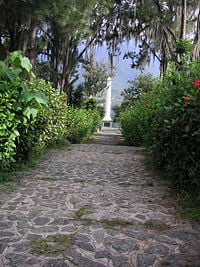
Chávez promoted his "Bolivarian Revolution" as a model for other countries to follow. The policy calls for the establishment of a "multipolar" world devoid of U.S. influence and for greater integration among developing countries. Venezuela is currently advocating regional integration through its PetroCaribe and PetroSur petroleum initiatives, the creation of a South American Community of Nations, and the establishment of the Bolivarian Alternative for the Americas (a social integration project proposed by President Chavez as an alternative to the Free Trade Area of the Americas).
In April 2006, Chávez announced he was withdrawing Venezuela from the Andean Community trade bloc. In July 2006, Venezuela officially joined the Southern Common Market, MERCOSUR. Before it can become a full member of MERCOSUR, Venezuela must conform to the trade bloc's economic regulations. Congressional approval by Brazil and Paraguay is also still outstanding.
The Venezuelan government maintains very close relations—including close military and intelligence ties—with Cuba and advocates an end to Cuba's isolation.
After 2005, Chávez deepened relations with Iran, a state sponsor of terrorism, by signing multiple economic and social accords and publicly supporting Iran's controversial nuclear program. Chávez also reached out to North Korea, Belarus, and Syria. The Venezuelans have also embarked on a worldwide effort to increase their presence in embassies overseas in Africa and Asia.
Chávez also launched a major renovation of the Venezuelan armed forces by purchasing new advanced weaponry. In 2005-2006, Venezuela purchased 100,000 AK-103 rifles from Russia and signed an agreement to construct a rifle and ammunition complex. Venezuela also purchased dozens of Russian attack and transport helicopters and has begun receiving 24 Russian Sukhoi Su-30MK 2-seat fighters.
Venezuela has long-standing border disputes with Colombia—aggravated by the capture of a Colombian insurgent leader inside Venezuela—and Guyana, but seeks in general to resolve them peacefully. Bilateral commissions have been established by Venezuela and Colombia to address a range of pending issues, including resolution of the maritime boundary in the Gulf of Venezuela. Relations with Guyana are complicated by Venezuela's claim to roughly three-quarters of Guyana's territory. Since 1987, the two countries have held exchanges on the boundary under the "good offices" of the United Nations.
Military
Venezuela's national armed forces include roughly 87,500 personnel spread through four service branches: the Ground Forces, the Navy (including the Marine Corps), the Air Force, and the Armed Forces of Cooperation (FAC), commonly known as the National Guard. As of 2005, a further 100,000 soldiers were incorporated into a new fifth branch, known as the Armed Reserve; these troops bear more semblance to a militia than the older branches. The president is the commander-in-chief of the national armed forces.
Economy
The petroleum sector dominates Venezuela's mixed economy, accounting for roughly a third of GDP, around 80 percent of exports and more than half of government revenues. The country's main petroleum deposits are located around and beneath Lake Maracaibo and the Gulf of Venezuela. The oil sector operates through the state-owned Petróleos de Venezuela (PDVSA), whose subsidiaries include the distributor CITGO. Other major exports are bauxite and aluminum, steel, petrochemicals, and agricultural produce. Venezuela's main trading partners are the United States, Colombia, Brazil, and Mexico. In line with Chavez's promise to turn the country into a socialist state, Venezuela withdrew from the World Bank and International Monetary Fund and is undergoing a rapid nationalization program.
Venezuela is also highly dependent on its agriculture. Sectors with major potential for export-led growth are production of both coffee and cocoa crops. At one time, Venezuela ranked close to Colombia in coffee production, but in the 1960s and 1970s, as petroleum temporarily turned Venezuela into the richest country in South America, coffee was relegated to the economic back burner.
In the first decade of the twenty-first century Venezuela produced less than one percent of the world's coffee, most of it consumed by the domestic market. However, Venezuelan coffees are again entering North American specialty markets. Venezuela's cocoa industry has decayed since the days of Spanish colonialism, when African slaves worked on cocoa estates. The focus of cocoa cultivation has long since moved to tropical West Africa. In recent years, there has been an attempt to resuscitate this industry, as its rare variety of cacao, known as Chuao, is considered the finest and most aromatic in the world and is used in certain single-origin chocolates. The largest Venezuelan fine chocolate producer is El Rey, though some companies such as Savoy (Nestlé) also manufacture chocolate from Venezuelan cacao and export it to Europe.
Venezuela is one of the five founding members of OPEC, which was the initiative of Venezuelan politician Juan Pablo Pérez Alfonzo; it was proposed in 1960 as a response to low domestic and international oil prices. Since 2005, Venezuela has also been an unratified member of MERCOSUR, joining Brazil, Argentina, Paraguay, and Uruguay; it has yet to gain voting rights. Venezuela is also a member of the Union of South American Nations (Unasul-Unasur).
Demographics
Half of the estimated 27,483,200 Venezuelans are mestizo (mixed white and indigenous ancestry); another 41 percent are white Latin American, mostly of Italian, Spanish, German, and Portuguese stock. Other important minority groups include Afro-Venezuelans (7 percent), and Asians (2 percent), who are of predominantly Arab or Chinese descent. Only one percent of Venezuelans are Native Americans.
These groups were joined by sponsored migrants from throughout Europe and neighboring parts of South America during waves of immigration in the early twentieth century; many were attracted again by the mid-century economic boom. About 85 percent of the population live in urban areas in northern Venezuela; 73 percent live less than 100 kilometers (62 mi) from the coastline. Though almost half of Venezuela's land area lies south of the Orinoco, only 5 percent of Venezuelans live there.
The national and official language is Spanish; 31 indigenous languages are also spoken, including Guajibo, Pemon, Warao, Wayuu, and the various Yanomaman languages. European immigrant communities and their descendants commonly use their own native languages. Nominally, 96 percent of the population belongs to the Roman Catholic Church.
Culture
Venezuela's heritage, art, and culture have been heavily influenced by its Latin American context. These elements extend to its historic buildings, architecture, art, landscape, boundaries, and monuments. Venezuelan culture has been shaped by indigenous, Spanish and Italian, and some African influences. Before this period, indigenous culture was expressed in art (petroglyphs), crafts, architecture (shabonos), and social organization. Aboriginal culture was subsequently assimilated by Spaniards; over the years, the hybrid culture diversified by region.
Venezuelan art is gaining prominence. Initially dominated by religious motifs, it began emphasizing historical and heroic representations in the late nineteenth century. Modernism took over in the twentieth century.
Venezuelan literature originated soon after the Spanish conquest of the mostly pre-literate indigenous societies; it was dominated by Spanish influences. Following the rise of political literature during the War of Independence, Venezuelan Romanticism emerged as the first important genre in the region.
The national musical instrument is the cuatro. Typical musical styles and pieces mainly emerged in and around the llanos region. The national dance is the joropo.
Baseball is Venezuela's most popular sport, although football (soccer), spearheaded by the Venezuela national football team, is gaining influence.
Notes
- ↑ 1.0 1.1 1.2 1.3 1.4 Error on call to template:cite web: Parameters url and title must be specified. International Monetary Fund.
- ↑ The Ramsar Convention on Wetlands, August 2, 2006, The Annotated Ramsar List of Wetlands of International Importance. Retrieved May 29, 2017.
- ↑ Simon Romero, Venezuela Hands Narrow Defeat to Chávez Plan, New York Times. Retrieved May 29, 2017.
- ↑ Chavez defeated over reform vote BBC, December 3, 2007. Retrieved May 29, 2017.
ReferencesISBN links support NWE through referral fees
- Carroll, Rory. Comandante: Hugo Chavez's Venezuela. Penguin Press, 2013. ISBN 978-1594204579
- Gott, Richard. Hugo Chavez: The Bolivarian Revolution in Venezuela. Verso, 2005. ISBN 978-1844675333
- Tarver, H. Micheal, and Julia C. Frederick. The History of Venezuela. Palgrave Macmillan, 2006. ISBN 978-1403962607
External links
All links retrieved May 3, 2023.
Credits
New World Encyclopedia writers and editors rewrote and completed the Wikipedia article in accordance with New World Encyclopedia standards. This article abides by terms of the Creative Commons CC-by-sa 3.0 License (CC-by-sa), which may be used and disseminated with proper attribution. Credit is due under the terms of this license that can reference both the New World Encyclopedia contributors and the selfless volunteer contributors of the Wikimedia Foundation. To cite this article click here for a list of acceptable citing formats.The history of earlier contributions by wikipedians is accessible to researchers here:
- Venezuela history
- Bolivarian_Revolution history
- History_of_Venezuela history
- Venezuelan_constitutional_referendum,_2007 history
The history of this article since it was imported to New World Encyclopedia:
Note: Some restrictions may apply to use of individual images which are separately licensed.


